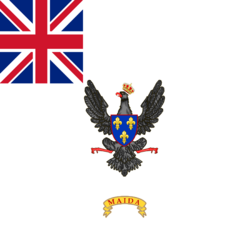Royal Sicilian Regiment facts for kids
Quick facts for kids Royal Sicilian Regiment |
|
|---|---|

Regimental Colours of the Royal Sicilian Regiment of Foot
|
|
| Active | 10 May 1806–1816 |
| Country | |
| Branch | |
| Type | Light Infantry |
| Size | one battalion (1350 men max in 1812) |
| Garrison/HQ | Floriana HQ, Malta |
| Colors | white flag, with a black flying eagle, crowned, bearing an escutcheon with the three fleur-de-lys of the Bourbon dynasty |
| Engagements | Battle of Maida, Alexandria expedition of 1807, Peninsular War |
| Battle honours | Maida |
| Commanders | |
| Colonel of the Regiment |
John C. Sherbrooke Ronald C. Ferguson |
| Notable commanders |
Francesco Rivarola |
The Royal Sicilian Regiment was a special group of soldiers. They were also called the Royal Sicilian Regiment of Foot. These soldiers were from Sicily. They fought with the British Army during the Napoleonic Wars. This was a big war in Europe. The regiment existed from 1806 until 1816.
How the Royal Sicilian Regiment Started
The regiment began as a small group of volunteers. They were put together in Sicily. Major Count Francesco Rivarola started the group. He got permission from King Ferdinand I. He also got permission from British General Sir John Stuart. They let him find soldiers in Messina.
This group, like other foreign units, had local soldiers. But it had a mix of British and local officers. The soldiers were paid well. They got food like bread and meat. They were trained just like British soldiers. Their first home base was a church and monastery in Messina.
First Battle Experience
The volunteers fought their first battle very quickly. It was only two months after they started. A small group of them fought at the Battle of Maida. This happened on July 4, 1806. They joined two companies of the Royal Corsican Rangers. They were part of a special light brigade. This group was led by Colonel James Kempt. After this win, the volunteers went back to Messina.
The next year, in March 1807, the Royal Sicilian Volunteers went on a mission. They sailed to Constantinople. General Alexander Mackenzie Fraser led this trip. But the mission changed. They went to the Alexandria expedition of 1807 instead. This mission did not go well. The unit was now led by Colonel John Coape Sherbrooke. They defended a place called the Citadel of Qaitbay. Soldiers nicknamed it "the Cut." In the end, 10 soldiers were killed. Seven more were hurt.
After this mission, they returned to Messina. They were allowed to find more soldiers. By this time, the regiment had ten companies. Two more were added in 1808. Then, they were sent to Malta. They helped make the army there stronger.
Becoming a Full Regiment
In 1808, the volunteer group became a full regiment. They got their own special rules. There was a ceremony in Malta. It happened at Floriana Barracks on March 2, 1809. They received their regimental flag. It was a white flag with a black flying eagle. The eagle had a crown. It also had a shield with three golden lilies. These lilies were a symbol of the Bourbon royal family. General Sir Hildebrand Oakes gave them the flag. He was the British commander in Malta. The Regiment stayed in Malta. Colonel Ronald C. Ferguson led them. He took command on January 25, 1809.
Regiment Structure
Each company in the regiment was set up like this:
- 4 officers
- 6 sergeants
- 5 corporals
- 4 acting corporals
- 1 artisan (a skilled worker)
- 10 carabiniers (special sharpshooters with rifles and sword bayonets)
- 2 buglers (who played bugles for signals)
- 68 privates (regular soldiers)
In 1809, the Sicilian Regiment helped capture the Ionian Islands. These islands were taken from the French. The islands included Zante, Ithaca, Cephalonia, and Cerigo. Later, in 1812, they moved north to the island of Vis. The first group of soldiers stayed there for a while. They were with a group of Royal Artillery soldiers. The islands were fully captured in 1814. The Regiment also fought to capture Corfu.
While they were in Malta, the regiment helped a lot. They managed the terrible plague that year. Governor Thomas Maitland praised them highly for their work. The next year, the Regiment was supposed to go back to Britain. But Napoleon escaped from Elba. This stopped their return. The Sicilian Regiment was called to fight Joachim Murat in Italy instead.
The regiment was finally closed down on March 24, 1816. Many other foreign regiments in the British Army were also closed. One example was the King's German Legion.
Uniform and Appearance
In 1810, the Sicilian Regiment wore a bright red coat. This was the standard British infantry coat. It had dark green parts on the collar and cuffs. They had white lace on their uniforms. They wore a tall, stiff hat called a stovepipe shako. It had a bugle badge. This might have been changed later to a Tarleton helmet. They also had a green feather plume on their hats. They wore white pants and black gaiters. Gaiters are like leg coverings. Officers had gold colored metal parts on their uniforms. Their gold buttons had a royal crown. The words "Sicilian Regiment" were around the crown.
Leaders of the Regiment
- John Coape Sherbrooke. He was appointed on February 5, 1807.
- Ronald C. Ferguson. He was appointed on January 25, 1809.
See also

